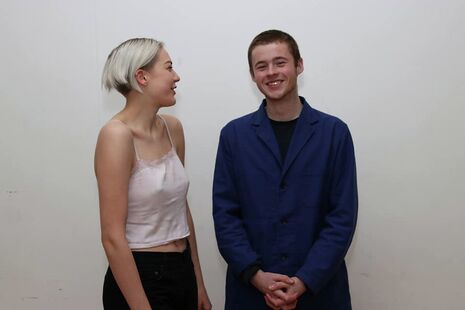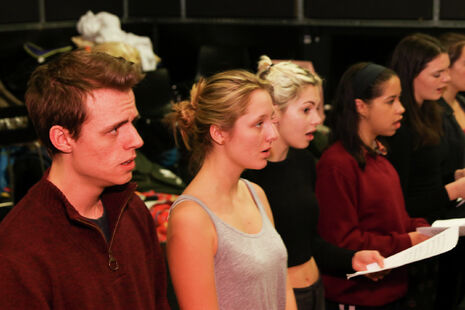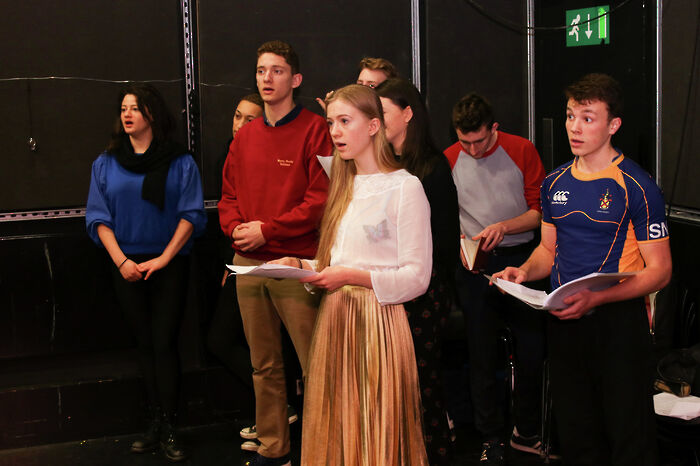Romeo and Juliet review: ‘dark delight’
Cambridge students take to the professional stage and our reviewer is highly impressed

A twang of Spanish guitar, and a stamp of heel, and Tom Littler has his audience in 1930s Andalusia, run by gangs of Montagues and Capulets. Forget the showcase, this is where the Marlowe Society shows off what its actors can do; how do they own the stage in a professional theatre, how do they serve the director’s vision? Littler’s Romeo and Juliet is an intoxicating and gloomy study of tragedy and love, but how were the students going to live up to the occasion?
As the lights go down, two women behind me whisper to themselves, “Oh my, the costumes!” Capulets in white linen and Montagues in sequined flamenco cloth, designed by Emily Stuart, invade the stage for a beginning brawl. The pull of a skirt and a twist of a hand print shadows on the set as figures clap, tap and click in the opening sequence. It is so lovely to see choreography in student theatre at Cambridge. Beth Hindhaugh, playing the Prince, is immediately sharp, cutting through the messy fight, and setting the tone for a night of consistently strong female characters.
The female characters glow and provoke. Matilda Wickham, playing Juliet, is often physically above Romeo, whether that be on the famous balcony, or on the centre stage plinths. The fact that Juliet is supposed to be thirteen is conveniently ignored; Wickham plays Juliet as sexually confident, laying on the bed with legs spread apart. In this respect, Romeo comes to her, she does not go to Romeo. Wickham is taller with short blonde hair, composed and strong; when Romeo and Juliet look at each other, it feels as if Juliet is staring down Romeo, daring him to take the lead. She teaches him to love: “O, swear not by the moon, th' inconstant moon, / That monthly changes in her circle orb”, she demands. This Juliet is witty, quick, verbal. When Romeo breathlessly enquires, “What light through yonder window breaks?”, Juliet is sur le balon, smoking a lit fag, deep in contemplation. Wickham is the perfect vessel for this interpretation; it feels as if she is a highly aware, intelligent women struggling with the irrational emotions provoked by her star-crossed encounter with Romeo. It is frustrating, however, that the actual moment of meeting itself, so memorably imagined by Baz Luhrmann in his film, feels really forced; the spotlight is turned on the lovers in a moment which is supposed to replicate romantic acknowledgment, but it feels more teenage house party than high drama.

Another gripe is the stomping. The hard foot movements of flamenco are repeated as rhythmic motif throughout Romeo and Juliet. When it is good, it is really good, especially in the Queen Mab speech. When it is bad, it obscures some important parts of the narrative. I think one of my favourite lines of the play — “I bite my thumb at you, Sir” — was cut, but I can’t be one hundred per cent sure, because maybe it was just lost under the ‘Spanish’ stamping. And yet the dancing is important, as a threatening, physical thorn in Shakespeare’s rosy verse.
Directors of Romeo and Juliet have blended heat, murder and lust since Zeffirelli and before. Shakespeare sets the play in Italy, after all. In this sense, the Arts show is quite traditional; it takes the playwright’s idea, and moves the location some hundred miles west to south Spain. But Littler's effect is still thrilling in 2018; the sting of the actors cigarettes’ in the opening scenes, diffusing through the stalls, the orange lighting effects, cloaking the arches of the cathedral set, both provide the sensual architecture for a removal from Cambridge, England, to Civil War Andalusia. A threat of violence always lingers, strikingly symbolised by the strapped blade on Mercutio’s thigh. The silver knife winks and glimmers throughout Romeo and Juliet, and is a charismatic prop choice from the stage management team. The sound it makes as actors flick it open is chilling, a warning of things to come. Saskia Ross, as Mercutio, uses the dagger to great effect in a breathtaking fight scene, touchingly playing off her “scratch" with laddish laughter and jokes. The artifice of braggadocio falls away, and she ends showering screeches of blame. At points, I wanted more of this. Only Ross and John Tothill manage to ferment the spittle and bile of subtextual hatred and prejudice, and it was the responsibility of the supporting cast to carry this. Romeo and Juliet are enclosed in their own mistakes.
Harry Redding as Romeo puts in a good performance, especially in scenes with Benvolio. You want to be in his jocular friendship group. But Romeo is always in the dominion of monied Juliet. “I should kill thee with much cherishing,” she says. While she is younger, he comes across as inexperienced. While he is a noble, his clothes are threadbare. I’m willing to go along with Littler’s insistence on a cultural difference between the two houses: “The Montagues reference the indigenous gitano, or Romany, population.” While Redding may be yet to reach the pinnacle of his abilities at Cambridge, it is very nice to see Tothill, a third year known for being one of Cambridge’s best comedians, glide around the different demands of comedy and tragedy.
The show contained fluid gender swapping. Why must it be that if a role is gender swapped, the performance of that role necessities a female actor dressing up in male clothes? Littler seems to agree with the need to question this; Ross is dressed in a lush flamenco dress, which she uses to great effect in the Queen Mab speech, and with big black boots and short hair. Cambridge theatre understands that a woman can play a character written for man, but it shouldn’t impose traditionally male clothes, like braces or trilby hats, on women who take those parts. Hindhaugh, playing a role written for man, is striking in female linen suit. But Peter, the message ‘boy’, played well by Hannah Shury-Smith, was dressed in high-waisted trousers and braces. Why can’t messengers look how the other women look?
Returning to the Marlowe Society production, Littler’s show is dark delight to watch, and is Cambridge Theatre at its best.
Romeo and Juliet is on at the Cambridge Arts Theatre until Saturday 27 January
 News / Clare Hall spent over £500k opposing busway 24 December 2025
News / Clare Hall spent over £500k opposing busway 24 December 2025 News / Caius mourns its tree-mendous loss23 December 2025
News / Caius mourns its tree-mendous loss23 December 2025 Comment / The ‘class’ of Cambridge24 December 2025
Comment / The ‘class’ of Cambridge24 December 2025 Comment / Yes, I’m brown – but I have more important things to say22 December 2025
Comment / Yes, I’m brown – but I have more important things to say22 December 2025 Interviews / Politics, your own way: Tilly Middlehurst on speaking out21 December 2025
Interviews / Politics, your own way: Tilly Middlehurst on speaking out21 December 2025










